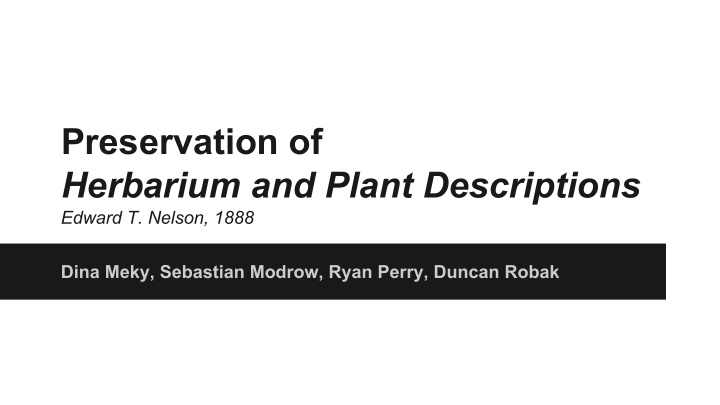



Preservation of Herbarium and Plant Descriptions Edward T. Nelson, 1888 Dina Meky, Sebastian Modrow, Ryan Perry, Duncan Robak
The Object ● Published in 1888 ● Designed as a guide and container for collecting plant specimens ● Unbound, individual pamphlets ● Blank spaces for users to fill in details about collected specimens
The Object ● Our copy was found among Ryan’s family papers ● Filled out by Rhoda Perry in May 1897 ● Paper is well-preserved ○ Shows some signs of discoloration ● Cover is distorted from storage
The Object ● Contains roughly 38 plant specimens ● Organic material is relatively well-preserved ○ Shows some signs of mold and disintegration
Preservation Plan “Do as little harm “When in doubt, as possible” make a box” 1. Construction of a phase box 2. Preservation of plant material 3. Digitization and access
A Phase Box as Protective Enclosure “ [E]nclosures can serve two purposes—to hold together an item with several parts, whether a book Advantages in a Nutshell: with loose boards or a filmstrip and its accompanying audiotape; and to - stabilizes weak book structures protect special items, such as fragile books of historical importance or - no change of the physicality or books with fine bindings.” arrangement of the actual book - effective sunlight protection
The Physicality of the Phase Box ● Acid free barrier or phase box board = no harm to the enclosed object ● Inner + outer box = all-around protection for 3D-objects ● Velcro fasteners = box remains closed + easy to open
Tools and Materials Needed Dimensions of the Book: 9.75 by 7.5 by 1.5 inches ● B arrier board (at least 23 by 18 inches) ● Double-sided tape (or PVA) Material ● Small Velcro fasteners ● Ruler ● X-Acto knife Tools ● Bone folder ● (Brush if using PVA)
The Inner Box 2 x height + 2 x depth + ⅛” – ¼” = 22.625 inches
The Outer Box 2 x breadth of the book + 2 x depth + ⅛” - ¼” = 17.25 inches
High Efficiency at Low Costs Why a Phase Box for the Herbarium ? ● Especially well suited for protecting loose- leaf, unbound book structures ● Plant specimens difficult to remove without damage, i.e. protective enclosure the least intrusive option ● High cost-effectiveness with regard to the actual monetary value of the book
Preserving Plants : Paper Type Things to consider: ● The specimens were mounted into the book in May 1897. ● The paper of the Herbarium should consist of either 100% alpha cellulose or cotton rag paper that is acid free and pH neutral. ● Over time, the acid in the plants has resulted in the discoloration of the pages to a yellowish color.
Treatment Suggestions Preservation suggestions include: ● Placing the mounted plant in the freezer for a few days to kill insects ● Placing the plants under multiple layers of newspaper, blotting paper, cardboard and wood ● Placing the specimen in a microwave oven to dry it out, though the sources note that this process would decrease the ultimate usefulness and longevity of the plant
How to get rid of Mold and Mildew Determine whether the mold is wet or dry: ● Wet mold is in fuzzy spots or patches or can be in spider web-like forms. ● Dry mold is dry and powdery.
How to get rid of mold and mildew, cont. Ventilation is considered the best course of action for mold ● Ventilate in a well aired, isolated area ● Ventilate away from fans and air conditioner ○ The spores could still be harmful ● Use a soft, dry brush or cloth to wipe mold away. ● Use a HEPA-filtered vacuum cleaner fitted with a micro-vacuum attachment to reduce the level of suction to gently remove mold spores from the surface.
Alternative means of treatment Fumigation (examples like using chemical treatments such as ethylene oxide) may kill off mold and mildew but it does not eliminate the need to physically clean and ventilate the mold from items. It can also cause harm to the object and to the person administering the treatment.
Why Digitize? ● Increases longevity of plant specimens ● Reduces need of physical handingly ● Broader access ● Creates additional formats
Best Option for Image 1.Platform scanner 2.Flatbed scanner 3.Digital camera (DSLR) 4.Digital backs
Camera Procedures ● Clean specimen ● Position mounting sheet ○ Clear specimen ○ Clear data ● Avoid “specks” ● Process image digitally
Dublin Core
Formats ● Paper ● CD/DVD ● Digital Copy
Different Media ● Provide back-up in the event of a preservation disaster ● Reduce need for physical handingly of the object ● Potentially provides broader access ● Preserve intellectual content of the object ● Digital media need periodic upkeep to conform to changing technologies
Digitization Even though this object is from a personal collection and is unlikely to ever be apart of a herbarium database, digitization is a crucial aspect to the overall preservation of the book.
Conclusion ● Herbarium will not last forever, but with the plan we have outlined, its longevity will be extended. ● While a more intrusive preservation plan could increase longevity, the risk of damaging the fragile plant matter and the expense of other methods outweigh the potential benefits.
Recommend
More recommend